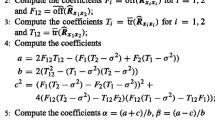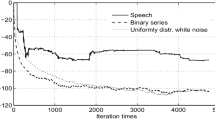Abstract
Channel identification techniques that do not require the use of a training sequence (blind methods), or that can operate with very short training sequence (semiblind methods) are a topic of major concern for modern communication applications. This paper presents a review of channel identification methods that are applicable in this context, with a strong emphasis on second-order subspace-based and maximum likelihood (Ml) estimation schemes. The main focus of the paper is on: (i) providing a clear picture of the principle and theory associated with subspace-based methods in the blind and semi-blind contexts; (ii) describing algorithmic solutions, sometimes based on novel results, that are suitable for carrying out the delicate likelihood optimization task associated withMl estimation.
Résumé
Les techniques d’estimation, qu’elles soient autodidactes (c’est-à-dire n’utilisant pas de connaissance a priori sur l’information émise) ou semi-autodidactes (basées sur la connaissance par exemple d’une séquence d’apprentissage), constituent depuis de nombreuses années un sujet d’intérêt majeur dans le domaine des télécommunications, et plus particulièrement pour l’identification des canaux de transmission. Cet article se propose de présenter une synthèse des développements récents dans ce domaine, en présentant en particulier les techniques sous-espace exploitant les statistiques du second ordre ainsi que les méthodes de maximum de vraisemblance. L’article s’organise de manière suivante: on présente tout d’abord le principe des techniques sous-espace ainsi que les résultats théoriques essentiels concernant à la fois les contextes autodidacte et semi-autodidacte; dans un second temps, sont considérées des solutions algorithmiques, pour certaines utilisant des résultats très récents, permettant de mettre en ceuvre l’approche par maximum de vraisemblance avec un coût d’implémentation raisonnable.
Similar content being viewed by others
References
Abed-Meraim (K.), Cardoso (J. F.), Gorokhov (A.), Loubaton (P.), Moulines (E.), On subspaces methods for blind identifiction of single-input multiple-output fir systems.IEEE Transactions on Signal Processing,45 (1): 42–55, (January 1997).
Baum (L. E.), Petrie (T. P.), Soules (G.), Weiss (N.), A maximization technique occuring in the statistical analysis of probabilistic functions of Markov chains.The Annals of Mathematical Statistics,41 (1): 164–171, (1970).
Brockwell (P. J.), Davis (R. A.), Times series: Theory and methods.Springer, second edition, (1991).
Buchoux (V.), Moulines (E.), Cappé (O.), Gorokhov (A.). Semi-blind subspace techniques for digital communication systems.IEEE Transactions on Signal Processing,98. To be submitted.
Buchoux (V.), Moulines (E.), Cappé (O.), Mayrargue (S.), On the feasability of the blind and semi-blind techniques in digital communications systems.Work-shop COST 254, Emerging techniques for Communication Terminals, July 1997.Enseeith-enst, Toulouse France.
Caines (P. E.), Linear stochastic systems.Wiley, (1988).
Cappé (O.), Buchoux (V.), Moulines (E.), Quasi-newton method for maximum likelihood estimation of hidden Markov models.Proc. 1CASSP, IV: 2265–2268, Seattle. (May 1998).
Cappé (O.), Doucet (A.), Lavielle (M.), Moulines (E.), Simulation-based methods for blind maximum-likelihood filter identification.To appear in Signal Processing,73 (1), (1999).
Cappé (O.) dcv: A set of matlab functions for blind deconvolution of discrete signals, http://tsi.enst.fr/~Cappe/dcvérb, (Nov. 1998).
Collings (I. B.), Ryden (T.), A new maximum likelihood gradient algorithm for on-line hidden Markov model identification. InProc. ICASSP, pp. 2261–2264, Seattle, (1998).
Dempster (A. P.), Laird (N. M.), Rubin (D. B.), Maximum likelihood from incomplete data viaEm algorithm.J. Royal Statistical Society,39 (Ser. B), (1997).
Ding (Z.). Multipath channel identification based on partial system information.IEEE Trans, on Sig. Proc., (Jan. 1997).
Slock (D.), De Carvalho (E.), Asymptotic performance of ml methods for semi-blind channel estimation.Proc. of Slst Asilomar Conf. on Signals, Systems, Computers,2: 1624–1628, (Nov. 1997).
Forney (G. D.), Minimal bases of rational vector spaces, with applications to multivariable linear systems.S1AM J. on Control,13 (3): 493–520, (May 1975).
Gorokhov (A.), Loubaton (P.), Semi-blind second order identification of convolutive channels.Proc. ICASSP, pp. 3905–3908, 1997.
Tsatsanis (M. K.), Cirpan (H. A.), Stochastic maximum likelihood methods for semi-blind channel equalization.IEEE Transactions on Signal Processing,5 (1): 21–24, (January 1998).
Moore (J. B.), Collings (I. B.), Krishnamurthy (V.), On-line identification of hidden Markov models via recursive prediction error techniques.IEEE Transactions on Signal Processing, IEEE,42 (12): 3535–3539, (December 1994).
Slock (D. T. M.), Ayadi (J.) De Carvalho (E.), Blind and semiblind maximum likelihood methods for fir multichannel identification.Proc. ICASSP,6: 3185, (1998).
Fonollosa (J. A. R.), Anton-Haro (C.), Fonollosa (J. R.), Blind channel estimation and data detection using hidden Markov models.IEEE Transactions on Signal Processing, IEEE,45(l):241–246, (Jan. 1997).
Johnson (C. R.), Schniter (P.), Endres (T. J.), Behm (J. D.), Brown (D. R.), Casas (R.), Blind equalization using the constant modulus criterion: a review.Proceedings of the IEEE,86 (10): 1927–1951, (Oct. 1998).
Abed Meraim (K.), Loubaton (P.), Moulines (E.), A subspace algorithm for certain subspace blind identification problems.IEEE Transactions on Information Theory,43 (2): 499–511, (March 1997).
Kailath (T), Linear Systems.Prentice-Hall, Inc., (1980).
Kawas Kaleh (G.), Vallet (R.), Joint parameter estimation and symbol detection for linear or nonlinear unknown channels.IEEE Transactions on Communications,42 (7): 2406–2413, (July 1994).
Kay (S. M.), Fundamentals of statistical signal processing: Estimation theory.Signal processing series. Prentice-hall, (1993).
Koopman (S. J.), Disturbance smoother for state space models.Biometrika,80 (1): 117–126,(1993).
Krishnamurthy (V.), White (L. B.), Blind equalization ofFir channels with Markov inputs. InProc. IFAC Identification and system parameter estimation, (1992).
LeGland (R), Mevel (L.), Recursive estimation inHmms. In36th IEEE Conf. on decision and control, San Diego, (1997).
Paulraj (A.), Cedervall (M.), Ng (B.), Structured methods for blind multi-channel identification.Proc. 13th Int. Conf. Dig. Sig. Proc., (July 1997).
MacDonald (I. L.), Zucchini (W.), Hidden Markov models and other models for discrete-valued time series.Chapman & Hall, (1997).
Mendel (J.), Tutorial on high-order statistics (Spectra) in signal processing and system theory.Proceedings on the IEEE,79 (3): 278–305,(1991).
Mevel (L.), Statistique asymptotique pour les modèles de Markov caché.,PhD thesis, Université de Rennes 1, (1997).
Loubaton (P.), Ciblat (P.), Second order blind equalization: the band limited case.Proc. ICASSP, (1998).
Giridhar (K.), Iltis (R.), Shynk (J.), Bayesian algorithms for blind equalization using parallel adaptive filtering.IEEE Transactions on Communications,42: 1017–1032, (1994).
Rabiner (L.), A tutorial on hidden Markov models and selected applications in speech recognition.Proceedings of the IEEE,77 (2): 257–274, (Feb. 1989).
Moore (J. B.), Elliot (R. J.), Aggoun (L.), Hidden Markov models: estimation and control.Springer-Verlag, New York, (1994).
Schell (S.), Smith (D.), Gardner (W.), Blind channel identification using cyclostationary statistics.Proc. EUSIPCO, pp. 716–719, (1994).
Titterington (M.), Recursive parameter estimation using incomplete data.J. Royal Statist. Soc. Ser. B,46 (2): 257–267, (1984).
Tong (L.), Perreau (S.), Multichannel blind identification: from subspace to maximum likelihood methods.Proceedings of the IEEE,86 (10): 1951–1968, (October 1998).
Tong (L.), Xu (G.), Kailath (T.), A new approach to blind identification and equalization of multipath channels. InProc. of the 25th Asilomar Conference, Pacific Grove, CA, pp. 856–860, (1991).
Paulraj (A.), Reddy (V.), Papadias (C.), Blind identifiability of certain classes of multipath channels from second order using antenna arrays.IEEE Signal Processing Letters, (May 1997).
Wu (C. F. J.), On the convergence properties of theEm algorithm.The Annals of Mathematical Statistics,11 (1): 95–103, (1983).
Author information
Authors and Affiliations
Corresponding authors
Rights and permissions
About this article
Cite this article
Buchoux, V., Perros-Meilhac, L., Cappé, O. et al. Blind and semi-blind equalization: methods and algorithms. Ann. Télécommun. 53, 449–465 (1998). https://doi.org/10.1007/BF02998591
Received:
Issue Date:
DOI: https://doi.org/10.1007/BF02998591
Key words
- Equalization
- Unsupervised learning
- Transmission channel
- Identification
- Maximum likelihood
- Vector space
- Rational function
- Hidden Markov model
- Statistical estimation
- Review
- Methodology
- Algorithm




